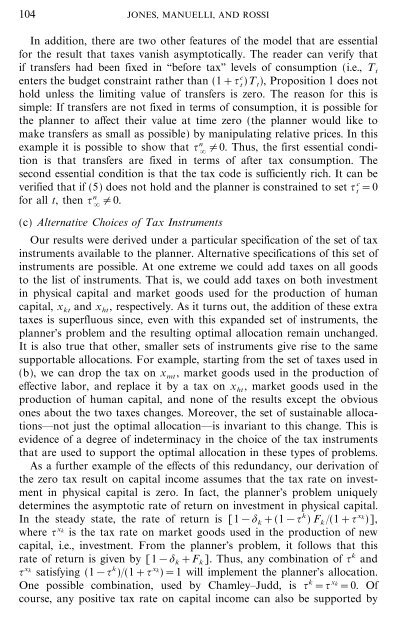On the Optimal Taxation of Capital Income
On the Optimal Taxation of Capital Income
On the Optimal Taxation of Capital Income
You also want an ePaper? Increase the reach of your titles
YUMPU automatically turns print PDFs into web optimized ePapers that Google loves.
104 JONES, MANUELLI, AND ROSSI<br />
In addition, <strong>the</strong>re are two o<strong>the</strong>r features <strong>of</strong> <strong>the</strong> model that are essential<br />
for <strong>the</strong> result that taxes vanish asymptotically. The reader can verify that<br />
if transfers had been fixed in ``before tax'' levels <strong>of</strong> consumption (i.e., T t<br />
enters <strong>the</strong> budget constraint ra<strong>the</strong>r than (1+{ c<br />
t )T t), Proposition 1 does not<br />
hold unless <strong>the</strong> limiting value <strong>of</strong> transfers is zero. The reason for this is<br />
simple: If transfers are not fixed in terms <strong>of</strong> consumption, it is possible for<br />
<strong>the</strong> planner to affect <strong>the</strong>ir value at time zero (<strong>the</strong> planner would like to<br />
make transfers as small as possible) by manipulating relative prices. In this<br />
example it is possible to show that { n {0. Thus, <strong>the</strong> first essential condition<br />
is that transfers are fixed in terms <strong>of</strong> after tax consumption. The<br />
second essential condition is that <strong>the</strong> tax code is sufficiently rich. It can be<br />
verified that if (5) does not hold and <strong>the</strong> planner is constrained to set { c<br />
t =0<br />
for all t, <strong>the</strong>n { n {0.<br />
(c) Alternative Choices <strong>of</strong> Tax Instruments<br />
Our results were derived under a particular specification <strong>of</strong> <strong>the</strong> set <strong>of</strong> tax<br />
instruments available to <strong>the</strong> planner. Alternative specifications <strong>of</strong> this set <strong>of</strong><br />
instruments are possible. At one extreme we could add taxes on all goods<br />
to <strong>the</strong> list <strong>of</strong> instruments. That is, we could add taxes on both investment<br />
in physical capital and market goods used for <strong>the</strong> production <strong>of</strong> human<br />
capital, xkt and xht, respectively. As it turns out, <strong>the</strong> addition <strong>of</strong> <strong>the</strong>se extra<br />
taxes is superfluous since, even with this expanded set <strong>of</strong> instruments, <strong>the</strong><br />
planner's problem and <strong>the</strong> resulting optimal allocation remain unchanged.<br />
It is also true that o<strong>the</strong>r, smaller sets <strong>of</strong> instruments give rise to <strong>the</strong> same<br />
supportable allocations. For example, starting from <strong>the</strong> set <strong>of</strong> taxes used in<br />
(b), we can drop <strong>the</strong> tax on xmt, market goods used in <strong>the</strong> production <strong>of</strong><br />
effective labor, and replace it by a tax on xht, market goods used in <strong>the</strong><br />
production <strong>of</strong> human capital, and none <strong>of</strong> <strong>the</strong> results except <strong>the</strong> obvious<br />
ones about <strong>the</strong> two taxes changes. Moreover, <strong>the</strong> set <strong>of</strong> sustainable allocations<br />
not just <strong>the</strong> optimal allocation is invariant to this change. This is<br />
evidence <strong>of</strong> a degree <strong>of</strong> indeterminacy in <strong>the</strong> choice <strong>of</strong> <strong>the</strong> tax instruments<br />
that are used to support <strong>the</strong> optimal allocation in <strong>the</strong>se types <strong>of</strong> problems.<br />
As a fur<strong>the</strong>r example <strong>of</strong> <strong>the</strong> effects <strong>of</strong> this redundancy, our derivation <strong>of</strong><br />
<strong>the</strong> zero tax result on capital income assumes that <strong>the</strong> tax rate on investment<br />
in physical capital is zero. In fact, <strong>the</strong> planner's problem uniquely<br />
determines <strong>the</strong> asymptotic rate <strong>of</strong> return on investment in physical capital.<br />
In <strong>the</strong> steady state, <strong>the</strong> rate <strong>of</strong> return is [1&$ k+(1&{ k ) Fk (1+{ xk )],<br />
where { xk is <strong>the</strong> tax rate on market goods used in <strong>the</strong> production <strong>of</strong> new<br />
capital, i.e., investment. From <strong>the</strong> planner's problem, it follows that this<br />
rate <strong>of</strong> return is given by [1&$ k+F k]. Thus, any combination <strong>of</strong> { k and<br />
{ xk k xk satisfying (1&{ ) (1+{ )=1 will implement <strong>the</strong> planner's allocation.<br />
<strong>On</strong>e possible combination, used by Chamley Judd, is { k ={ xk =0. Of<br />
course, any positive tax rate on capital income can also be supported by
















